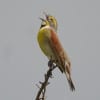 By Jim Stevenson
By Jim Stevenson
I’m in South Dakota, about to take a morning off and visit the four presidents at Mt. Rushmore who are stoned out of their minds. Then, it’s back to visiting NWRs and National Parks for next year’s Great Plains trip. Attached is the remainder of this spring’s songbirds, without the color of the ones last week. Hope you enjoy them. Later this week you’ll get the non-birds and next week we’ll start the Great Plains birds.
Hope some of you saw the video that went viral of the cat that ran outside and protected the boy from a bad neighborhood dog. That was really amazing!!!
Thanks again for another great spring.
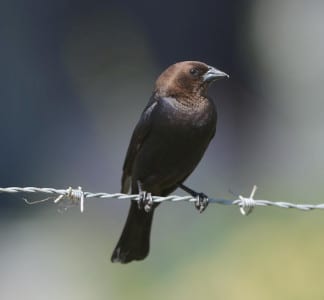
Brown-headed Cowbirds are brood parasites that weren’t a problem until present human agriculture exploded their population. Now they spend much of the morning mating and females dropping their eggs into other songbird nests. You can see the brown head but now the Bronzed Cowbird has gotten quite regular, and the Shiny isn’t far away!
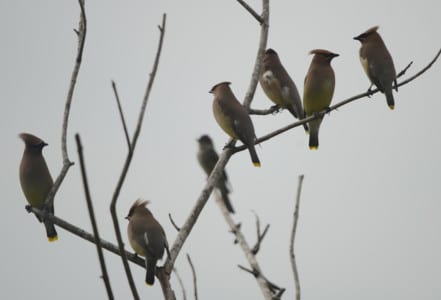
Cedar Waxwings cross the Gulf in early May, long after our wintering birds have exited. This small group (and a pewee) dropped in around the Tenth of May, right before I was leaving. They are shaped a bit like starlings in the air, but the brown hue and large crest separates them. Listen for their high-pitched notes.
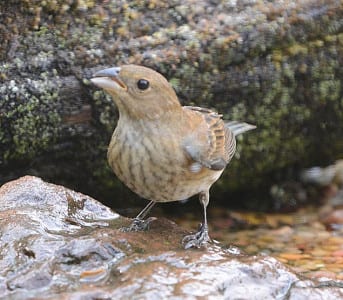
Not all birds fit the profile, and this young Indigo Bunting has a curved top of the bill (like a Varied) and streaks not commonly seen in Indigo Buntings. I did the right thing in taking lotsa pictures, as I was suspicious, but it wasn’t a big deal. Many of the young buntings can be very hard to distinguish
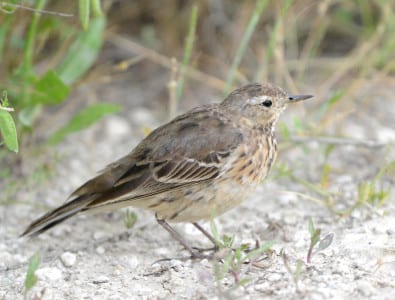
American Pipits are scattered around in winter but this very late bird was caught molting into breeding plumage. Note the thin bill (for insects), which separates it from sparrows and other similar, ground-dwelling species. They also bob their tails, a great field mark for pipits. They are also flat gray on top, unlike Sprague’s Pipits.
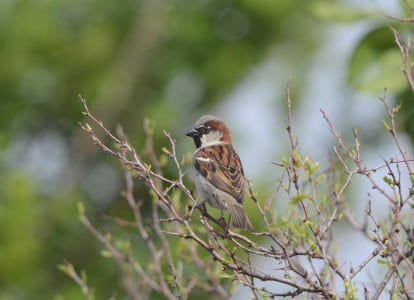
An abundant European immigrant, the House Sparrow mostly occupies towns, but will stray into farmland as its numbers increase. This is actually the nominate of all songbirds (60% of our birds), as the order is Passeriformes, and the genus of the House Sparrow is Passer. Hard to believe we named our best avian order after this creature.
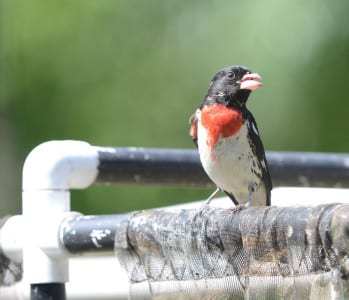
This Rose-breasted Grosbeak is one of the few injured birds I’ve seen flying around, as if it had few cares in the World. It has a chunk taken out of the upper mandible, but seems no worse for the wear. Almost making fun of my photo friends, he’s landed on the top of Alan Murphy’s blind, saying, “shoot me!”
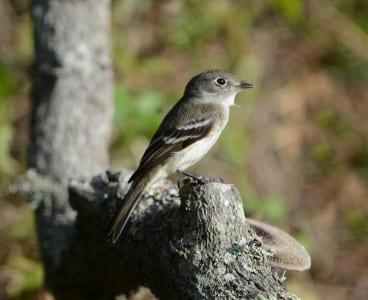
If you know this species, you oughtta be writing your own PDFs. OK, it’s a tiny Least Flycatcher, one of the troublesome Empidonax flycatchers that confound and confuse birders. Note the oversized head, white eyering (whitest behind the eye), grayish-brown back, active in the open, and they are constantly flitting their wings. Piece of cake…
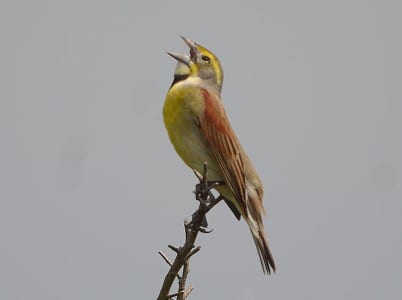
Dickcissels are finches that attempt to nest in various grasslands of the Upper Texas Coast, but they have trouble convincing females to stay. Interesting how many birds with brown backs and yellow chests (often with a black bib) breed in the World’s grasslands, even though they are unrelated songbirds. These odd colors are then called convergence.
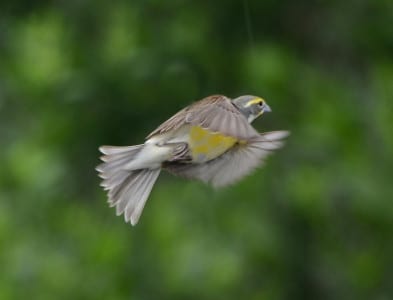
Birds that migrate from continent to continent have more pointed wings than those which stick around North America, or don’t migrate at all. This Dickcissel has gradually longer primaries to the end of the wing, and they mostly fly from well into South America up to the northern United States. The vast majority pass through our area within five days of April 20, perhaps celebrating Earth Day???
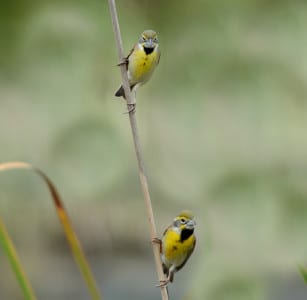
Male Dickcissels are decked out with a black bib, a la meadowlarks. Several others south of the Equator that also live in grasslands have this color scheme, but are not related to the two birds discussed here. This is textbook convergence, in one of the most poignant examples in ornithology. It is the habitat that gives them their similar colors and patterns.
![Telling the meadowlarks apart is a lot harder that you might think, unless they call. [Yes, I *know* it’s calling!] Many times, the angle from which we view a bird determines what field marks we use. Note the dark streaks on the side of the subject. That’s an Eastern. It often sings in Baccharis, as that’s the tallest shrub around.](https://www.crystalbeachlocalnews.com/wp-content/uploads/2014/05/Assorted-Songbirds10-404x300.jpg)
Telling the meadowlarks apart is a lot harder that you might think, unless they call. [Yes, I *know* it’s calling!] Many times, the angle from which we view a bird determines what field marks we use. Note the dark streaks on the side of the subject. That’s an Eastern. It often sings in Baccharis, as that’s the tallest shrub around.
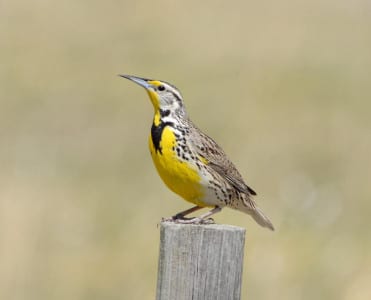
Do you see how much less this bird’s sides are streaked? This bugger is a male Western Meadowlark singing, & he’d be sounding way more like an oriole. I find the information in the field guide on the facial differences confusing at times, and recommend these flanks, wings and tail.
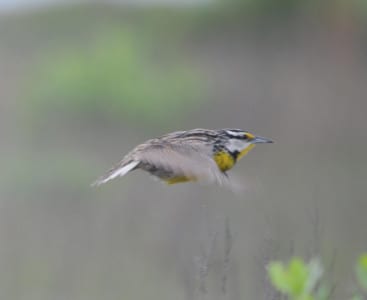
Both meadowlarks are short, stocky birds with white outer tail feathers and stubby wings like starlings. They are both grassland birds and face the fields AWAY from the roads, as they are trying to woo females when they are singing. Their long bills are used to work grass for ‘hoppers, which starlings also do (with similar beaks). It’s called “bill gaping.”
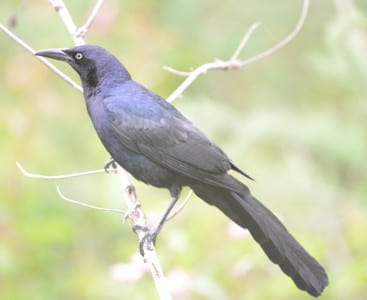
You haven’t had a Great-tailed Grackle from me in a while. There.
![But WOW, this one is really cool! This gal has “partial albinism” or leucocism. It really needs to beware, as abnormally-colored birds stick out and are picked off by accipiters and falcons. [And I was thinking how much it looked like vanilla icing.] I have only seen one other grackle species with this condition, but the great-tails were frequently seen with it a decade ago in Brazosport.](https://www.crystalbeachlocalnews.com/wp-content/uploads/2014/05/Assorted-Songbirds14-380x300.jpg)
But WOW, this one is really cool! This gal has “partial albinism” or leucocism. It really needs to beware, as abnormally-colored birds stick out and are picked off by accipiters and falcons. [And I was thinking how much it looked like vanilla icing.] I have only seen one other grackle species with this condition, but the great-tails were frequently seen with it a decade ago in Brazosport.
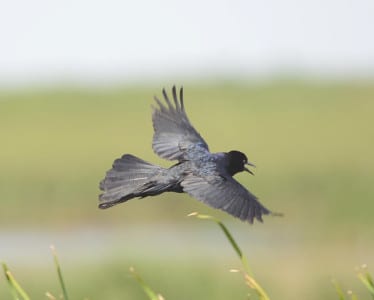
Boat-tailed Grackles west of Florida have brown eyes and all have these rounded heads. They love freshwater marshes and make a var iety of shrieks and whistles. In winter they sometimes roost with great-tails, such as one on Follet’s Island. It’s a good way to compare how one holds its wings higher than the other species while courting.
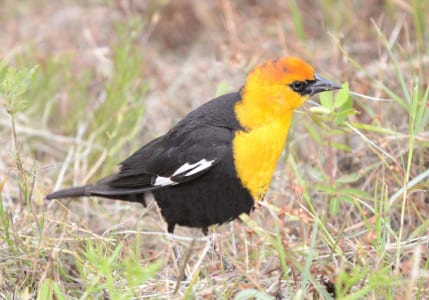
Yellow-headed Blackbirds are Great Plains and western birds, but this one appeared just west of the Bridge between Follet’s and Galveston Islands. It was blind in its left eye and therefore quite tame. Now in the Upper Great Plains, I am seeing them in every cattail marsh, honking and contorting their bodies for their prospective brides.
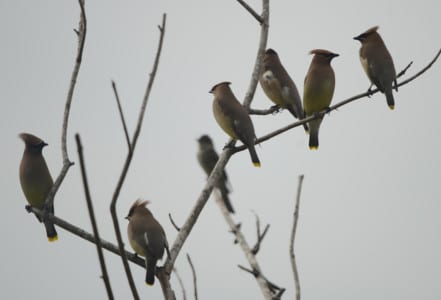
Right on schedule, these half-dozen Cedar Waxwings showed up in my yard in early May, fresh from a flight from the Yucatan. Our birds wintering in the South have been gone for weeks, so there’s a bit of a hiatus in their spring schedule. I’m pretty sure they are poking fun at the pewee behind them, calling him “skinny” and such.
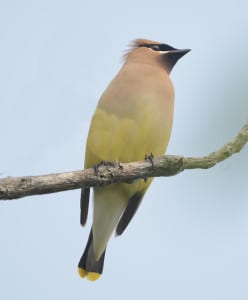
This waxwing has a condition that’s either xanthothroism, or maybe a poor Photoshop job. 😉 We often see this species from the underside, so you can see the yellow-tipped tail and the white vent. I record many of my waxwings by their thin, high-pitched calls, too high for some of my clients to hear.
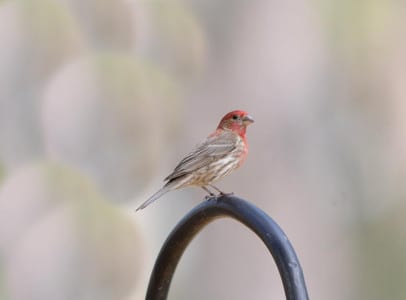
House Finches have spread like wildfire the past few decades, and are in many of the neighborhoods in Houston. Semidomestic, they also call like House Sparrows, but the streaks on both sexes easily separate them from those weaver finches we call House Sparrows, and a few other names.
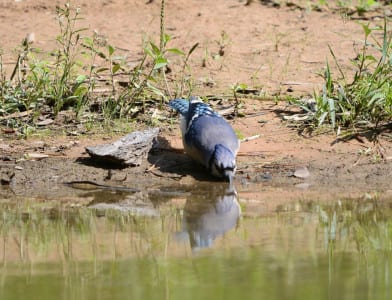
Blue Jays are scarce on Galveston and most are wintering birds from the northern race (subspecies). They are larger and noisier. This bird is a southern bird drinking at a pond in NW Houston, always watchful of predators. They not only mob hawks and owls, they imitate certain hawks, like especially red-shouldereds.
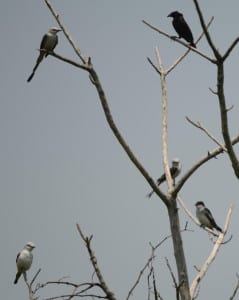
And lastly, a potpourri of songbirds, with three scissor-tails, an Eastern Kingbird and a Bronzed Cowbird* who wants to egg dump their nest. Good luck with that, as most years these two flycatchers don’t stay and nest. But I have had more good birds in that tall, dead tree, and I’d recommend one in your yard. *Note the neck ruff and longish bill.

 Posted in
Posted in 























